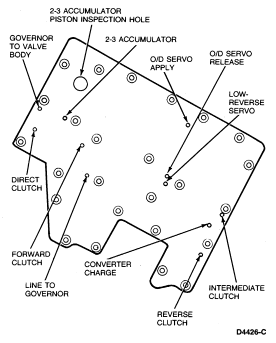
Section 07-01B: Transmission, Automatic—AOD | 1993 Mustang Workshop Manual |
Troubleshooting the automatic transmission is simplified by using the proven method of diagnosis. One of the most important things to remember is that there is a definite procedure to follow. Do not take short cuts or assume that critical checks or adjustments have already been made.
The following procedures are recommended for checking and/or verifying that the various components are adjusted and operating properly. Use Rotunda Automatic Transmission Tester 014-00737 or equivalent. Follow the manufacturer's instructions.
NOTE: The passages can be tested adequately with air pressure regulated at 276 kPa (40 psi). However, it may be necessary to use higher air pressure of 620 kPa (90 psi) if there is difficulty in hearing the clutches apply.
A no drive condition can exist, even with the correct transmission fluid pressure, because of an inoperative clutch or band. The inoperative units can be located through a series of checks by substituting air pressure for the fluid pressure to determine the location of the malfunction.
For example, when the selector lever is in D or (D), a no drive condition may be caused by an inoperative forward clutch or one-way roller clutch. When there is no drive in 1, the difficulty could be caused by improper functioning of the forward clutch or low-reverse band and the one-way roller clutch. Failure to drive in reverse range could be caused by a malfunction of the reverse clutch, or low-reverse band or clutch. In each case, refer to the applicable Clutch and Band Application Chart to relate faulty transmission operation to a specific hydraulic component.
When there is a slip condition but it is not known whether it is in the valve body or in the hydraulic system beyond the valve body, the air pressure tests can be very valuable.
To make the air pressure checks, loosen the oil pan bolts and lower one edge of the oil pan to drain the transmission fluid. Remove the fluid pan and the control valve body assembly.The inoperative units can be located by introducing air pressure into the transmission case passages leading to the clutches, servos and governor.
If a servo or the accumulator does not operate, disassemble, clean and inspect to locate the source of the trouble. If air pressure applied to a clutch passage fails to operate the clutch or operates two clutches at once, check the fluid passages in the case and front pump to detect obstructions or damage.
To air test the automatic overdrive transmission, a main control to case gasket (Base No. 7D100) and the following Special Service Tools will be required:
With the main control body removed, position the adapter plate and gasket on the transmission. Install the adapter plate retaining screws and tighten the screws to 9-11 Nm (80-97 lb-in). Note that each passage is identified on the plate. Using the air nozzle equipped with the rubber tip, apply air pressure to each passage in the following order:
Reverse Clutch
Apply air pressure to the reverse clutch passage in the service tool. A dull thud can be heard when the clutch piston applies. In addition, movement of the reverse clutch drum may also be detected.
Forward Clutch
Apply air pressure to the forward clutch apply passage in the service tool plate. A dull thud can be heard or movement of the piston can be felt on the case as the clutch piston is applied.
Intermediate Clutch
Apply air pressure to the intermediate clutch passage in the service tool plate. A dull thud can be heard or felt when the clutch applies.
Overdrive Servo
Apply air pressure to the overdrive O/D servo apply passage in the
service tool plate. Operation of the band is indicated by the tightening of the
band around the reverse clutch drum. The O/D servo will return to the release
position as a result of spring force from the release spring. Also, when the
servo returns to the release position, a thud can be felt on the O/D servo
cover. The band will then relax. 
Low-Reverse Servo
Apply air pressure to the low-reverse servo passage in the service tool plate. A dull thud can be heard when the low-reverse band tightens around the planetary assembly drum surface. Movement of the ring gear can also be detected.
Direct Clutch
Apply air pressure to the direct clutch apply passage. A dull thud should be heard or felt on the driveshaft if the clutch is operating.
2-3 Accumulator
Apply air pressure to the 2-3 accumulator passage. The accumulator piston should unseat. This can be detected by inserting a metal rod into the 2-3 piston hole. When the piston unseats, the rod will move. A thud can also be heard when the piston applies.
Governor
In order to air pressure check the line to governor passage and the governor to valve body passage, remove the driveshaft crossmember and extension housing.
Apply air pressure to the line to governor passage while holding a finger near the governor valve. If air is felt exiting the valve, the passage is clear.
To air pressure check the governor to valve body passage, remove the governor. Apply air pressure to the passage while holding a finger over holes in the output shaft. If air exits one of the holes, the passage is clear.